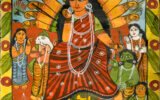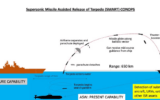
March 23 2024 Prelims Practice Questions (PPQs)
Subscribe to Never Miss an Important Update! Assured Discounts on New Products!
Must Join PMF IAS Telegram Channel & PMF IAS History Telegram Channel
- These Prelims Practice Questions (PPQs) are based on PMF IAS Daily Current Affairs.
- The daily current affairs are uploaded every day by 8 PM. You can read the Daily Current Affairs from here.
- Subscribers of the “Current Affairs” course can Download Daily Current Affairs in PDF/DOC from here.
[Quiz] Daily Prelims Practice Questions (PPQs) – March 23 2024
0 of 12 questions completed
Questions:
- 1
- 2
- 3
- 4
- 5
- 6
- 7
- 8
- 9
- 10
- 11
- 12
Information
These MCQs are based on PMF IAS Daily Current Affairs. The daily current affairs are uploaded every day by 8 PM. You can read the Daily Current Affairs from here. Subscribers of the “Current Affairs” course can Download Daily Current Affairs in PDF/DOC from here.
You have already completed the Test before. Hence you can not start it again.
Test is loading...
You must sign in or sign up to start the Test.
You have to finish following quiz, to start this Test:
Your results are here!! for" [Quiz] Daily Prelims Practice Questions (PPQs) – March 23 2024 "
0 of 12 questions answered correctly
Your time:
Time has elapsed
Your Final Score is : 0
You have attempted : 0
Number of Correct Questions : 0 and scored 0
Number of Incorrect Questions : 0 and Negative marks 0
| Average score |
|
| Your score |
|
-
Not categorized
You have attempted: 0
Number of Correct Questions: 0 and scored 0
Number of Incorrect Questions: 0 and Negative marks 0
| Pos. | Name | Entered on | Points | Result |
|---|---|---|---|---|
| Table is loading | ||||
| No data available | ||||
- 1
- 2
- 3
- 4
- 5
- 6
- 7
- 8
- 9
- 10
- 11
- 12
- Answered
- Review
-
Question 1 of 12
1. Question
Q1. {Agri – Crops} Consider the following passage:
- It is a kharif crop. It requires temperature between 21 degrees and 30 degrees Celsius. Rainfall ranging between 50-75 cm is essential for its growth. At least 200 frost free days is also necessary for the plant to mature.
Which one of the following crop is being talked about based on the above passage?
Correct
Explanation
- Cotton is grown as a Kharif crop in India, with sowing typically done in the months of April-May, and harvesting occurring between September-November.
- It requires temperatures ranging between 21°C and 30°C for optimal growth.
- Cotton plants need around 200 frost-free days to mature and produce good quality fiber.
- Rainfall during the growing season should ideally range between 50-75 cm, as excessive rainfall can adversely affect the quality of the fiber.
- Black soil is appropriate for the growth of cotton because it has a high clay content and a good capacity to retain water.
Answer: (a) Cotton; Difficulty Level: Medium
Incorrect
Explanation
- Cotton is grown as a Kharif crop in India, with sowing typically done in the months of April-May, and harvesting occurring between September-November.
- It requires temperatures ranging between 21°C and 30°C for optimal growth.
- Cotton plants need around 200 frost-free days to mature and produce good quality fiber.
- Rainfall during the growing season should ideally range between 50-75 cm, as excessive rainfall can adversely affect the quality of the fiber.
- Black soil is appropriate for the growth of cotton because it has a high clay content and a good capacity to retain water.
Answer: (a) Cotton; Difficulty Level: Medium
Unattempted
Explanation
- Cotton is grown as a Kharif crop in India, with sowing typically done in the months of April-May, and harvesting occurring between September-November.
- It requires temperatures ranging between 21°C and 30°C for optimal growth.
- Cotton plants need around 200 frost-free days to mature and produce good quality fiber.
- Rainfall during the growing season should ideally range between 50-75 cm, as excessive rainfall can adversely affect the quality of the fiber.
- Black soil is appropriate for the growth of cotton because it has a high clay content and a good capacity to retain water.
Answer: (a) Cotton; Difficulty Level: Medium
-
Question 2 of 12
2. Question
Q2. {Prelims – Geo – PIN} Consider the following statements:
- Archaeological Survey of India or the Central Government take necessary measures to protect Geo Heritage sites in India.
- Any artefact or object of geological significance or interest, such as sediments, rocks, minerals, meteorites, is referred to as a geo-relic.
- Geo-Heritage sites in India are protected under Geo-Heritage Sites and Geo-relics (Preservation and Maintenance) Act, 2022.
- Tamil Nadu has the maximum number of Geo Heritage sites in India.
How many of the above statement(s) is/are correct?
Correct
Explanation
Statement 1 is incorrect
- Geoheritage sites are sites of rare and unique geological, geo-morphological, mineralogical, petrological, and paleontological significance, including caves and natural rock sculptures of national and international interest.
- Geological Survey of India (GSI) declares geo-heritage sites/ national geological monuments for protection and maintenance.
- GSI is a scientific agency in India to carry out geoscientific activities.
- In addition to conducting geological surveys and studies of India, it is one of the oldest organizations (founded in 1851) of its kind in the world and the second-oldest survey in India after the Survey of India (founded in 1767).
- GSI or the respective State governments take necessary measures to protect these sites.
Statement 2 is correct
- Sites containing geo-relics and phenomena, stratigraphic type sections, geological structures and geomorphic landforms, including caves, are considered geoheritage sites.
- Any artefact or object of geological significance or interest, such as sediments, rocks, minerals, meteorites, or fossils, is referred to as a Geo-Relic.
Statement 3 is incorrect
- The delipidated state of many of these Geo Heritage Sites shows the need for a geo-heritage Bill.
- The sites are threatened with destruction due to decay, population pressure, and changing social and economic conditions.
- Hence, the Ministry of Mines introduced the draft Geo-Heritage Sites and Geo-relics (Preservation and Maintenance) Bill, 2022.
- At present, the Bill has not been presented before the Union Cabinet by the Ministry of Mines and hence, currently, there is no legislation for the protection of geo-heritage sites in India.
Statement 4 is incorrect
- There are 34 Geological Heritage Sites in India.
- Rajasthan with 12 Geo Heritage Sites tops the list closely followed by Tamil Nadu (4), Andhra Pradesh (4) and Karnataka (4).
Answer: (a) Only one; Difficulty Level: Medium
Incorrect
Explanation
Statement 1 is incorrect
- Geoheritage sites are sites of rare and unique geological, geo-morphological, mineralogical, petrological, and paleontological significance, including caves and natural rock sculptures of national and international interest.
- Geological Survey of India (GSI) declares geo-heritage sites/ national geological monuments for protection and maintenance.
- GSI is a scientific agency in India to carry out geoscientific activities.
- In addition to conducting geological surveys and studies of India, it is one of the oldest organizations (founded in 1851) of its kind in the world and the second-oldest survey in India after the Survey of India (founded in 1767).
- GSI or the respective State governments take necessary measures to protect these sites.
Statement 2 is correct
- Sites containing geo-relics and phenomena, stratigraphic type sections, geological structures and geomorphic landforms, including caves, are considered geoheritage sites.
- Any artefact or object of geological significance or interest, such as sediments, rocks, minerals, meteorites, or fossils, is referred to as a Geo-Relic.
Statement 3 is incorrect
- The delipidated state of many of these Geo Heritage Sites shows the need for a geo-heritage Bill.
- The sites are threatened with destruction due to decay, population pressure, and changing social and economic conditions.
- Hence, the Ministry of Mines introduced the draft Geo-Heritage Sites and Geo-relics (Preservation and Maintenance) Bill, 2022.
- At present, the Bill has not been presented before the Union Cabinet by the Ministry of Mines and hence, currently, there is no legislation for the protection of geo-heritage sites in India.
Statement 4 is incorrect
- There are 34 Geological Heritage Sites in India.
- Rajasthan with 12 Geo Heritage Sites tops the list closely followed by Tamil Nadu (4), Andhra Pradesh (4) and Karnataka (4).
Answer: (a) Only one; Difficulty Level: Medium
Unattempted
Explanation
Statement 1 is incorrect
- Geoheritage sites are sites of rare and unique geological, geo-morphological, mineralogical, petrological, and paleontological significance, including caves and natural rock sculptures of national and international interest.
- Geological Survey of India (GSI) declares geo-heritage sites/ national geological monuments for protection and maintenance.
- GSI is a scientific agency in India to carry out geoscientific activities.
- In addition to conducting geological surveys and studies of India, it is one of the oldest organizations (founded in 1851) of its kind in the world and the second-oldest survey in India after the Survey of India (founded in 1767).
- GSI or the respective State governments take necessary measures to protect these sites.
Statement 2 is correct
- Sites containing geo-relics and phenomena, stratigraphic type sections, geological structures and geomorphic landforms, including caves, are considered geoheritage sites.
- Any artefact or object of geological significance or interest, such as sediments, rocks, minerals, meteorites, or fossils, is referred to as a Geo-Relic.
Statement 3 is incorrect
- The delipidated state of many of these Geo Heritage Sites shows the need for a geo-heritage Bill.
- The sites are threatened with destruction due to decay, population pressure, and changing social and economic conditions.
- Hence, the Ministry of Mines introduced the draft Geo-Heritage Sites and Geo-relics (Preservation and Maintenance) Bill, 2022.
- At present, the Bill has not been presented before the Union Cabinet by the Ministry of Mines and hence, currently, there is no legislation for the protection of geo-heritage sites in India.
Statement 4 is incorrect
- There are 34 Geological Heritage Sites in India.
- Rajasthan with 12 Geo Heritage Sites tops the list closely followed by Tamil Nadu (4), Andhra Pradesh (4) and Karnataka (4).
Answer: (a) Only one; Difficulty Level: Medium
-
Question 3 of 12
3. Question
Q3. {Geo – Rivers} Consider the following statements about the Shipra River:
- It originates in the Satpura Range from a hill called Dhupgarh.
- It flows across the Malwa Plateau to join the Chambal River.
- The holy city of Ujjain is located on the right bank of the Shipra River.
How many of the above statement is/are correct?
Correct
Explanation
Statement 1 is incorrect
- The Shipra, also known as the Kshipra, is a river in Madhya Pradesh state.
- It is a perennial river and is considered as sacred as the Ganga River by the Hindus.
- It originates in the Vindhya Range from a hill called Kakri-Tekdi, which is in the north of Dhar and situated at a distance of 11km from Ujjain.
Statement 2 is correct
- This river is 195km long, out of which 93km flow through Ujjain.
- It flows across the Malwa Plateau to join the Chambal River.
- The main tributaries of Shipra are the Khan and Gambhir River.
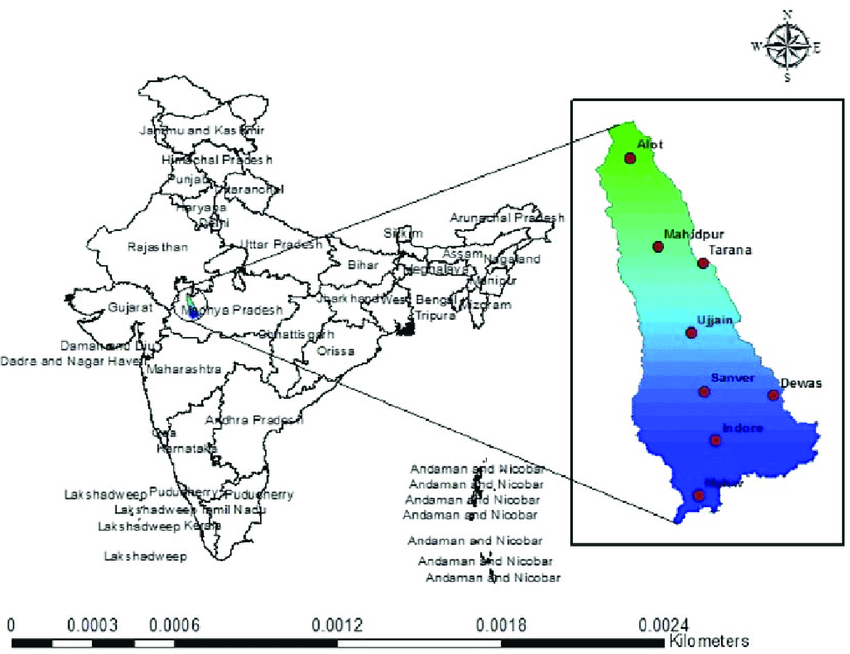
Statement 3 is correct
- The holy city of Ujjain is located on the right bank of the Shipra River.
- The famous Kumbha Mela takes place in the ghats of this city, once every 12 years, a yearly celebration of the river goddess Kshipra.
- Also on the banks of the Shipra is Sage Sandipani’s ashram or hermitage, where Krishna, Lord Vishnu’s eighth incarnation, had studied.
Answer: (b) Only two; Difficulty Level: Medium
Incorrect
Explanation
Statement 1 is incorrect
- The Shipra, also known as the Kshipra, is a river in Madhya Pradesh state.
- It is a perennial river and is considered as sacred as the Ganga River by the Hindus.
- It originates in the Vindhya Range from a hill called Kakri-Tekdi, which is in the north of Dhar and situated at a distance of 11km from Ujjain.
Statement 2 is correct
- This river is 195km long, out of which 93km flow through Ujjain.
- It flows across the Malwa Plateau to join the Chambal River.
- The main tributaries of Shipra are the Khan and Gambhir River.

Statement 3 is correct
- The holy city of Ujjain is located on the right bank of the Shipra River.
- The famous Kumbha Mela takes place in the ghats of this city, once every 12 years, a yearly celebration of the river goddess Kshipra.
- Also on the banks of the Shipra is Sage Sandipani’s ashram or hermitage, where Krishna, Lord Vishnu’s eighth incarnation, had studied.
Answer: (b) Only two; Difficulty Level: Medium
Unattempted
Explanation
Statement 1 is incorrect
- The Shipra, also known as the Kshipra, is a river in Madhya Pradesh state.
- It is a perennial river and is considered as sacred as the Ganga River by the Hindus.
- It originates in the Vindhya Range from a hill called Kakri-Tekdi, which is in the north of Dhar and situated at a distance of 11km from Ujjain.
Statement 2 is correct
- This river is 195km long, out of which 93km flow through Ujjain.
- It flows across the Malwa Plateau to join the Chambal River.
- The main tributaries of Shipra are the Khan and Gambhir River.

Statement 3 is correct
- The holy city of Ujjain is located on the right bank of the Shipra River.
- The famous Kumbha Mela takes place in the ghats of this city, once every 12 years, a yearly celebration of the river goddess Kshipra.
- Also on the banks of the Shipra is Sage Sandipani’s ashram or hermitage, where Krishna, Lord Vishnu’s eighth incarnation, had studied.
Answer: (b) Only two; Difficulty Level: Medium
-
Question 4 of 12
4. Question
Q4. {MIH – Personalities} Consider the following passage:
- She was a true Gandhian at heart, at the age of eight in 1928, she participated in a protest march against the Simon Commission. On 14 August 1942, she and her associates established the Secret Congress Radio during the Quit India Movement. She was later conferred with the Padma Vibhushan.
Which one of the following Freedom Fighter is being talked about based on the above passage?
Correct
Explanation
- Usha Mehta was born in a village named Saras, near Surat in Gujarat in 1920.
- She was a true Gandhian at heart and was popularly known as Ushaben.
- At the age of eight in 1928, she participated in a protest march against the Simon Commission.
- On 14 August 1942, she and her associates established the Secret Congress Radio during the Quit India Movement, a covert radio station that went on air on 27 August.
- It played a crucial role in keeping the freedom movement leaders connected with the public.
- At the advent of the World War II in 1939, the British had suspended all amateur radio licences across the Empire.
- Operators were supposed to turn in all equipment to the authorities, with severe punishment for those who failed to do so.
- Alongside Mehta, Babubhai Khakar, Vithalbhai Jhaveri, Nanak Gainchand Motwane and Chandrakant Jhaveri were key figures in organising Congress Radio.
- Vithalbhai and Motwane were acquitted, Mehta, Babubhai, and Chandrakant received stern sentences.
- Usha Mehta was released from Pune’s Yerawada Jail in March 1946, and hailed in the nationalist media as “Radio-ben”.
- She was conferred with Padma Vibhushan in 1998.
Answer: (d) Usha Mehta; Difficulty Level: Medium
Incorrect
Explanation
- Usha Mehta was born in a village named Saras, near Surat in Gujarat in 1920.
- She was a true Gandhian at heart and was popularly known as Ushaben.
- At the age of eight in 1928, she participated in a protest march against the Simon Commission.
- On 14 August 1942, she and her associates established the Secret Congress Radio during the Quit India Movement, a covert radio station that went on air on 27 August.
- It played a crucial role in keeping the freedom movement leaders connected with the public.
- At the advent of the World War II in 1939, the British had suspended all amateur radio licences across the Empire.
- Operators were supposed to turn in all equipment to the authorities, with severe punishment for those who failed to do so.
- Alongside Mehta, Babubhai Khakar, Vithalbhai Jhaveri, Nanak Gainchand Motwane and Chandrakant Jhaveri were key figures in organising Congress Radio.
- Vithalbhai and Motwane were acquitted, Mehta, Babubhai, and Chandrakant received stern sentences.
- Usha Mehta was released from Pune’s Yerawada Jail in March 1946, and hailed in the nationalist media as “Radio-ben”.
- She was conferred with Padma Vibhushan in 1998.
Answer: (d) Usha Mehta; Difficulty Level: Medium
Unattempted
Explanation
- Usha Mehta was born in a village named Saras, near Surat in Gujarat in 1920.
- She was a true Gandhian at heart and was popularly known as Ushaben.
- At the age of eight in 1928, she participated in a protest march against the Simon Commission.
- On 14 August 1942, she and her associates established the Secret Congress Radio during the Quit India Movement, a covert radio station that went on air on 27 August.
- It played a crucial role in keeping the freedom movement leaders connected with the public.
- At the advent of the World War II in 1939, the British had suspended all amateur radio licences across the Empire.
- Operators were supposed to turn in all equipment to the authorities, with severe punishment for those who failed to do so.
- Alongside Mehta, Babubhai Khakar, Vithalbhai Jhaveri, Nanak Gainchand Motwane and Chandrakant Jhaveri were key figures in organising Congress Radio.
- Vithalbhai and Motwane were acquitted, Mehta, Babubhai, and Chandrakant received stern sentences.
- Usha Mehta was released from Pune’s Yerawada Jail in March 1946, and hailed in the nationalist media as “Radio-ben”.
- She was conferred with Padma Vibhushan in 1998.
Answer: (d) Usha Mehta; Difficulty Level: Medium
-
Question 5 of 12
5. Question
Q5. {Envi – Species} Consider the following statements about Kashmir Hangul:
- It is the only Asiatic survivor or sub-species of the European red deer.
- It is listed as critically endangered in IUCN Red List.
- It is the State animal of Jammu and Kashmir and has seen an increase in its number due to J&Ks conservation efforts.
Which of the above statement(s) is/are correct?
Correct
Explanation
Statement 1 is correct
- Kashmir’s Hangul (Cervus hanglu hangul) is also known as the Kashmir stag or Kashmiri red stag which is highly shy and sensitive animal.
- It is the only Asiatic survivor or sub-species of the European red deer.
- It is endemic to the hills of Kashmir and restricted to the Dachigam National Park.
- It is in the Zabarwan Range of the western Himalayas and was established in 1981.
- A protected area since 1910, it was declared as a national park in 1981.
Statement 2 is correct
- Conservation Status
- IUCN – Critically endangered
- CITES – Appendix I
- Threats – Habitat loss, poaching.
Statement 3 is incorrect
- It is the State animal of Jammu and Kashmir.
- Despite conservation efforts, Kashmir’s hangul deer risk is facing extinction.
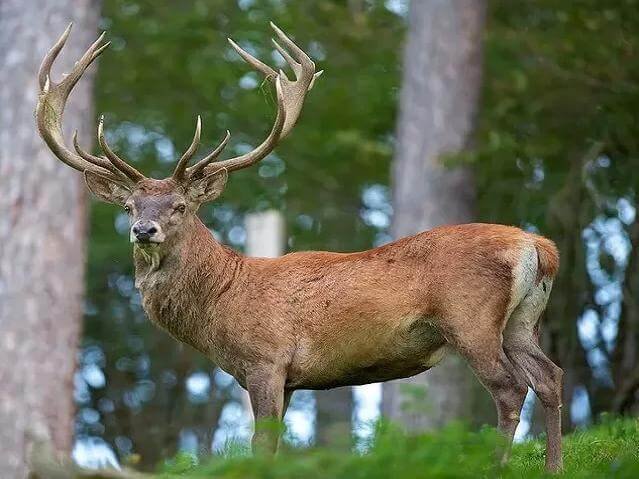
Answer: (a) 1 and 2 only; Difficulty Level: Medium
Incorrect
Explanation
Statement 1 is correct
- Kashmir’s Hangul (Cervus hanglu hangul) is also known as the Kashmir stag or Kashmiri red stag which is highly shy and sensitive animal.
- It is the only Asiatic survivor or sub-species of the European red deer.
- It is endemic to the hills of Kashmir and restricted to the Dachigam National Park.
- It is in the Zabarwan Range of the western Himalayas and was established in 1981.
- A protected area since 1910, it was declared as a national park in 1981.
Statement 2 is correct
- Conservation Status
- IUCN – Critically endangered
- CITES – Appendix I
- Threats – Habitat loss, poaching.
Statement 3 is incorrect
- It is the State animal of Jammu and Kashmir.
- Despite conservation efforts, Kashmir’s hangul deer risk is facing extinction.

Answer: (a) 1 and 2 only; Difficulty Level: Medium
Unattempted
Explanation
Statement 1 is correct
- Kashmir’s Hangul (Cervus hanglu hangul) is also known as the Kashmir stag or Kashmiri red stag which is highly shy and sensitive animal.
- It is the only Asiatic survivor or sub-species of the European red deer.
- It is endemic to the hills of Kashmir and restricted to the Dachigam National Park.
- It is in the Zabarwan Range of the western Himalayas and was established in 1981.
- A protected area since 1910, it was declared as a national park in 1981.
Statement 2 is correct
- Conservation Status
- IUCN – Critically endangered
- CITES – Appendix I
- Threats – Habitat loss, poaching.
Statement 3 is incorrect
- It is the State animal of Jammu and Kashmir.
- Despite conservation efforts, Kashmir’s hangul deer risk is facing extinction.

Answer: (a) 1 and 2 only; Difficulty Level: Medium
-
Question 6 of 12
6. Question
Q6. {S&T – Space} Consider the following statements about White Dwarf:
- It is the stellar core left behind after a dying star has exhausted its nuclear fuel.
- White dwarfs are one of the densest collections of matter, surpassed only by neutron stars.
Which of the above statement(s) is/are not correct?
Correct
Explanation
Statement 1 is correct
- A white dwarf is the stellar core left behind after a dying star has exhausted its nuclear fuel and expelled its outer layers to form a planetary nebula.
- It is what stars like the Sun become after they have exhausted their nuclear fuel.
- White dwarfs no longer support nuclear fusion reactions that generate energy, but they are still extremely hot.
Statement 2 is correct
- A typical white dwarf is half as massive as the Sun, yet only slightly bigger than Earth.
- This makes white dwarfs one of the densest collections of matter, surpassed only by neutron stars.
- A newly born white dwarf consists of helium, carbon, and oxygen nuclei, swimming in a sea of highly energetic electrons.
- The luminosity of white dwarfs can therefore be used by astronomers to measure how long-ago star formation began in a particular region.
- By providing important ‘fossil’ records of the stars that they formed from, white dwarfs are an important cosmological tool.
Answer: (d) Neither 1 nor 2; Difficulty Level: Medium
Incorrect
Explanation
Statement 1 is correct
- A white dwarf is the stellar core left behind after a dying star has exhausted its nuclear fuel and expelled its outer layers to form a planetary nebula.
- It is what stars like the Sun become after they have exhausted their nuclear fuel.
- White dwarfs no longer support nuclear fusion reactions that generate energy, but they are still extremely hot.
Statement 2 is correct
- A typical white dwarf is half as massive as the Sun, yet only slightly bigger than Earth.
- This makes white dwarfs one of the densest collections of matter, surpassed only by neutron stars.
- A newly born white dwarf consists of helium, carbon, and oxygen nuclei, swimming in a sea of highly energetic electrons.
- The luminosity of white dwarfs can therefore be used by astronomers to measure how long-ago star formation began in a particular region.
- By providing important ‘fossil’ records of the stars that they formed from, white dwarfs are an important cosmological tool.
Answer: (d) Neither 1 nor 2; Difficulty Level: Medium
Unattempted
Explanation
Statement 1 is correct
- A white dwarf is the stellar core left behind after a dying star has exhausted its nuclear fuel and expelled its outer layers to form a planetary nebula.
- It is what stars like the Sun become after they have exhausted their nuclear fuel.
- White dwarfs no longer support nuclear fusion reactions that generate energy, but they are still extremely hot.
Statement 2 is correct
- A typical white dwarf is half as massive as the Sun, yet only slightly bigger than Earth.
- This makes white dwarfs one of the densest collections of matter, surpassed only by neutron stars.
- A newly born white dwarf consists of helium, carbon, and oxygen nuclei, swimming in a sea of highly energetic electrons.
- The luminosity of white dwarfs can therefore be used by astronomers to measure how long-ago star formation began in a particular region.
- By providing important ‘fossil’ records of the stars that they formed from, white dwarfs are an important cosmological tool.
Answer: (d) Neither 1 nor 2; Difficulty Level: Medium
-
Question 7 of 12
7. Question
Q7. {Geo – Rivers} Consider the following statements with respect to Netravati River:
- The Netravati River, also known as the Bantwal River originates in the Bangrabalige valley of Yelaneeru Ghat in Karnataka.
- The Netravati is considered one of India’s holy rivers and flows through the famous pilgrimage site of Murudeshwar.
Which of the above statement(s) is/are correct?
Correct
Explanation
Statement 1 is correct
- The Netravati River, also known as the Bantwal River originates in the Bangrabalige valley of Yelaneeru Ghat in Karnataka.
- It joins the Kumaradhara River before emptying into the Arabian Sea.
- This river is the main source of water to Bantwal and Mangalore.
- The Netravati railway bridge is one of the known bridges which serve as the gateway to Mangalore.
- Many mini hydroelectric projects and diversion project have been set up on this river, causing damage to environment of this ecologically sensitive region; and more projects are in the planning stages and some are implemented.
Statement 2 is incorrect
- The Netravati is considered one of India’s holy rivers and flows through the famous pilgrimage site of Dharmasthala.
- Dharamasthala Temple is devoted to the Hindu god Manjunatha.
- The temple is unusual because it is a Hindu temple run by a Jain administration, and poojas are conducted by Hindu priests who subscribe to the Vaishnava ideologies.
- In 1973, a statue of Lord Bahubali, carved out of a single rock, was installed at Dharmasthala on a low hill near the Manjunatha Temple.
Answer: (a) 1 only; Difficulty Level: Medium
Incorrect
Explanation
Statement 1 is correct
- The Netravati River, also known as the Bantwal River originates in the Bangrabalige valley of Yelaneeru Ghat in Karnataka.
- It joins the Kumaradhara River before emptying into the Arabian Sea.
- This river is the main source of water to Bantwal and Mangalore.
- The Netravati railway bridge is one of the known bridges which serve as the gateway to Mangalore.
- Many mini hydroelectric projects and diversion project have been set up on this river, causing damage to environment of this ecologically sensitive region; and more projects are in the planning stages and some are implemented.
Statement 2 is incorrect
- The Netravati is considered one of India’s holy rivers and flows through the famous pilgrimage site of Dharmasthala.
- Dharamasthala Temple is devoted to the Hindu god Manjunatha.
- The temple is unusual because it is a Hindu temple run by a Jain administration, and poojas are conducted by Hindu priests who subscribe to the Vaishnava ideologies.
- In 1973, a statue of Lord Bahubali, carved out of a single rock, was installed at Dharmasthala on a low hill near the Manjunatha Temple.
Answer: (a) 1 only; Difficulty Level: Medium
Unattempted
Explanation
Statement 1 is correct
- The Netravati River, also known as the Bantwal River originates in the Bangrabalige valley of Yelaneeru Ghat in Karnataka.
- It joins the Kumaradhara River before emptying into the Arabian Sea.
- This river is the main source of water to Bantwal and Mangalore.
- The Netravati railway bridge is one of the known bridges which serve as the gateway to Mangalore.
- Many mini hydroelectric projects and diversion project have been set up on this river, causing damage to environment of this ecologically sensitive region; and more projects are in the planning stages and some are implemented.
Statement 2 is incorrect
- The Netravati is considered one of India’s holy rivers and flows through the famous pilgrimage site of Dharmasthala.
- Dharamasthala Temple is devoted to the Hindu god Manjunatha.
- The temple is unusual because it is a Hindu temple run by a Jain administration, and poojas are conducted by Hindu priests who subscribe to the Vaishnava ideologies.
- In 1973, a statue of Lord Bahubali, carved out of a single rock, was installed at Dharmasthala on a low hill near the Manjunatha Temple.
Answer: (a) 1 only; Difficulty Level: Medium
-
Question 8 of 12
8. Question
Q8. {Prelims – In News} Consider the following statements with respect to the Income and Wealth Inequality in India, 1922-2023:
- It is released by the NITI Aayog in collaboration with the National Statistical Organisation (NSO).
- The Ministry of Finance introduced the concept of Super Tax based on the recommendations of this report.
Which of the above statement(s) is/are not correct?
Correct
Explanation
Statement 1 is incorrect
- A new working paper, titled “Income and Wealth Inequality in India, 1922-2023: The Rise of the Billionaire Raj”, by World Inequality Lab has estimated that “inequality declined post-independence till the early 1980s, after which it began rising and has skyrocketed since the early 2000s”.
- The paper, which has been co-authored by Nitin Kumar Bharti, Lucas Chancel, Thomas Piketty, and Anmol Somanchi, combines data from national income accounts, wealth aggregates, tax tabulations, rich lists, and surveys on income, consumption, and wealth to arrive at the results.
- The World Inequality Lab is a Paris based global research center focused on the study of inequality and public policies that promote social, economic and environmental justice.
Statement 2 is incorrect
- Between 2014-15 and 2022-23, the rise of top-end inequality has been particularly pronounced in terms of wealth concentration.
- By 2022-23, top 1% income and wealth shares (22.6% and 40.1%) are at their highest historical levels.
- India’s top 1% income share is among the very highest in the world, higher than even South Africa, Brazil and US.
- In line with earlier work, the paper finds suggestive evidence that the Indian income tax system might be regressive when viewed from the lens of net wealth.
- A restructuring of the tax code to account for both income and wealth, and broad-based public investments in health, education and nutrition are needed to enable the average Indian.
- A super tax of 2% on the net wealth of the 167 wealthiest families in 2022-23 would yield 0.5% of national income in revenues and create valuable fiscal space to facilitate such investments.
- Super tax serves as a tool to fight inequality.
Answer: (c) Both 1 and 2; Difficulty Level: Medium
Incorrect
Explanation
Statement 1 is incorrect
- A new working paper, titled “Income and Wealth Inequality in India, 1922-2023: The Rise of the Billionaire Raj”, by World Inequality Lab has estimated that “inequality declined post-independence till the early 1980s, after which it began rising and has skyrocketed since the early 2000s”.
- The paper, which has been co-authored by Nitin Kumar Bharti, Lucas Chancel, Thomas Piketty, and Anmol Somanchi, combines data from national income accounts, wealth aggregates, tax tabulations, rich lists, and surveys on income, consumption, and wealth to arrive at the results.
- The World Inequality Lab is a Paris based global research center focused on the study of inequality and public policies that promote social, economic and environmental justice.
Statement 2 is incorrect
- Between 2014-15 and 2022-23, the rise of top-end inequality has been particularly pronounced in terms of wealth concentration.
- By 2022-23, top 1% income and wealth shares (22.6% and 40.1%) are at their highest historical levels.
- India’s top 1% income share is among the very highest in the world, higher than even South Africa, Brazil and US.
- In line with earlier work, the paper finds suggestive evidence that the Indian income tax system might be regressive when viewed from the lens of net wealth.
- A restructuring of the tax code to account for both income and wealth, and broad-based public investments in health, education and nutrition are needed to enable the average Indian.
- A super tax of 2% on the net wealth of the 167 wealthiest families in 2022-23 would yield 0.5% of national income in revenues and create valuable fiscal space to facilitate such investments.
- Super tax serves as a tool to fight inequality.
Answer: (c) Both 1 and 2; Difficulty Level: Medium
Unattempted
Explanation
Statement 1 is incorrect
- A new working paper, titled “Income and Wealth Inequality in India, 1922-2023: The Rise of the Billionaire Raj”, by World Inequality Lab has estimated that “inequality declined post-independence till the early 1980s, after which it began rising and has skyrocketed since the early 2000s”.
- The paper, which has been co-authored by Nitin Kumar Bharti, Lucas Chancel, Thomas Piketty, and Anmol Somanchi, combines data from national income accounts, wealth aggregates, tax tabulations, rich lists, and surveys on income, consumption, and wealth to arrive at the results.
- The World Inequality Lab is a Paris based global research center focused on the study of inequality and public policies that promote social, economic and environmental justice.
Statement 2 is incorrect
- Between 2014-15 and 2022-23, the rise of top-end inequality has been particularly pronounced in terms of wealth concentration.
- By 2022-23, top 1% income and wealth shares (22.6% and 40.1%) are at their highest historical levels.
- India’s top 1% income share is among the very highest in the world, higher than even South Africa, Brazil and US.
- In line with earlier work, the paper finds suggestive evidence that the Indian income tax system might be regressive when viewed from the lens of net wealth.
- A restructuring of the tax code to account for both income and wealth, and broad-based public investments in health, education and nutrition are needed to enable the average Indian.
- A super tax of 2% on the net wealth of the 167 wealthiest families in 2022-23 would yield 0.5% of national income in revenues and create valuable fiscal space to facilitate such investments.
- Super tax serves as a tool to fight inequality.
Answer: (c) Both 1 and 2; Difficulty Level: Medium
-
Question 9 of 12
9. Question
Q9. {IR – Pakistan} Arrange the following ports from East to West:
- Gwadar Port
- Chabahar Port
- Bandar Abbas Port
- Karachi Port
Select the correct code:
Correct
Explanation
- The Majeed Brigade of the separatist group Baloch Liberation Army (BLA) has claimed responsibility for Wednesday’s attack on a complex outside Pakistan’s strategic Gwadar Port.
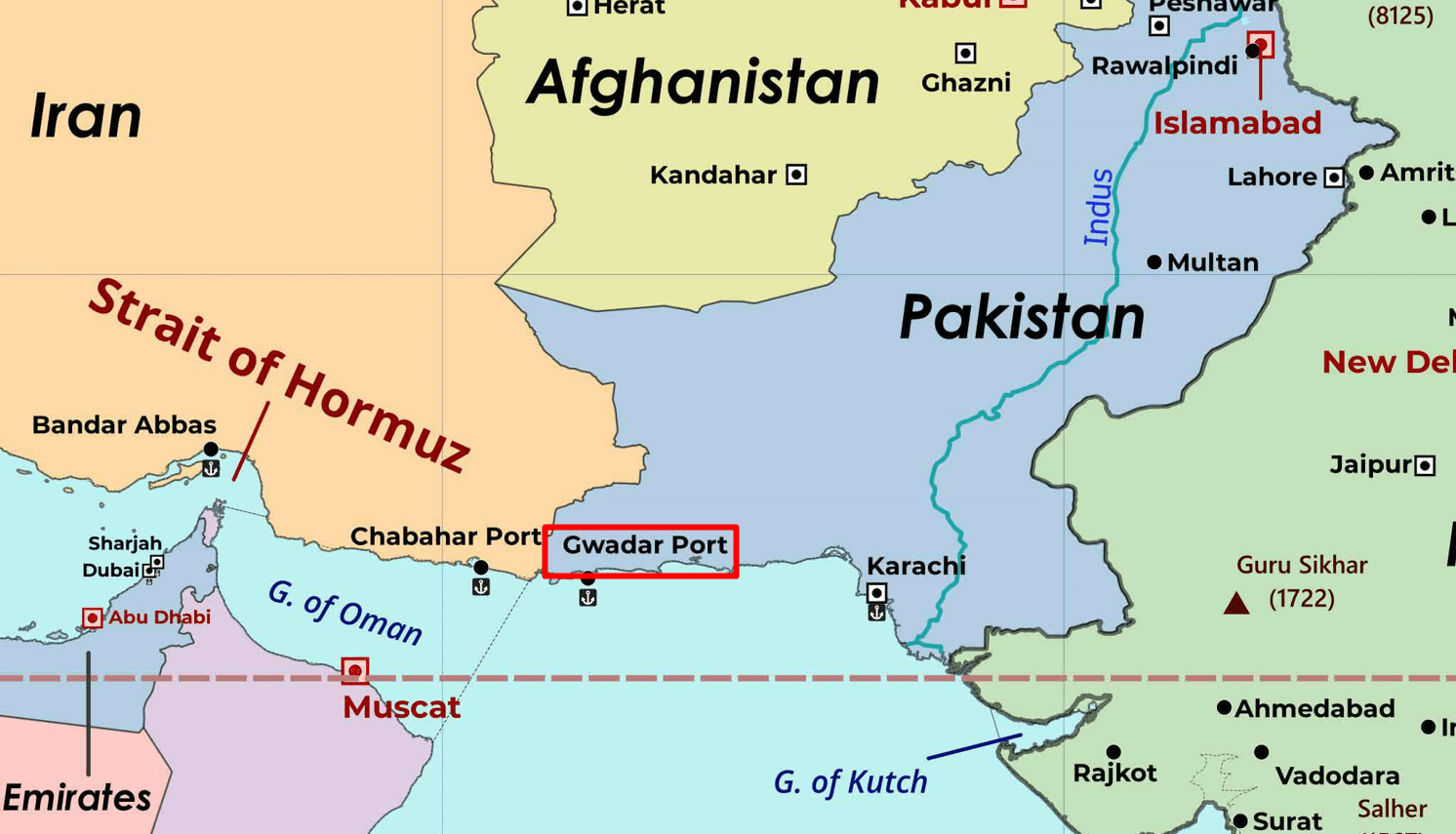
Answer: (d) 3-2-1-4; Difficulty Level: Medium
Incorrect
Explanation
- The Majeed Brigade of the separatist group Baloch Liberation Army (BLA) has claimed responsibility for Wednesday’s attack on a complex outside Pakistan’s strategic Gwadar Port.

Answer: (d) 3-2-1-4; Difficulty Level: Medium
Unattempted
Explanation
- The Majeed Brigade of the separatist group Baloch Liberation Army (BLA) has claimed responsibility for Wednesday’s attack on a complex outside Pakistan’s strategic Gwadar Port.

Answer: (d) 3-2-1-4; Difficulty Level: Medium
-
Question 10 of 12
10. Question
Q10. {Prelims – Agri – Crops} Recently, the government has approved inclusion of which crops under its price stabilization fund (PSF)?
Correct
Explanation
- The government has recently included wheat and rice in the Price Stabilization Fund (PSF).
- Established in 2014-15 under Department of Agriculture, Cooperation & Famers Welfare (DAC&FW), it was transferred to Department of Consumer Affairs (DOCA) in 2016.
- Managed centrally by Price Stabilization Fund Management Committee (PSFMC), it regulates proposals from State Governments and Central Agencies.
- Small Farmers’ Agribusiness Consortium (SFAC) maintains it as a central corpus fund.
- The fund aims to stabilize prices of selected commodities by distributing or procuring them, primarily used to counter high or low prices.
Answer: (b) Wheat and Rice; Difficulty Level: Medium
Incorrect
Explanation
- The government has recently included wheat and rice in the Price Stabilization Fund (PSF).
- Established in 2014-15 under Department of Agriculture, Cooperation & Famers Welfare (DAC&FW), it was transferred to Department of Consumer Affairs (DOCA) in 2016.
- Managed centrally by Price Stabilization Fund Management Committee (PSFMC), it regulates proposals from State Governments and Central Agencies.
- Small Farmers’ Agribusiness Consortium (SFAC) maintains it as a central corpus fund.
- The fund aims to stabilize prices of selected commodities by distributing or procuring them, primarily used to counter high or low prices.
Answer: (b) Wheat and Rice; Difficulty Level: Medium
Unattempted
Explanation
- The government has recently included wheat and rice in the Price Stabilization Fund (PSF).
- Established in 2014-15 under Department of Agriculture, Cooperation & Famers Welfare (DAC&FW), it was transferred to Department of Consumer Affairs (DOCA) in 2016.
- Managed centrally by Price Stabilization Fund Management Committee (PSFMC), it regulates proposals from State Governments and Central Agencies.
- Small Farmers’ Agribusiness Consortium (SFAC) maintains it as a central corpus fund.
- The fund aims to stabilize prices of selected commodities by distributing or procuring them, primarily used to counter high or low prices.
Answer: (b) Wheat and Rice; Difficulty Level: Medium
-
Question 11 of 12
11. Question
Q11. {IR – Groupings} SAMOA Pathway, recently seen in the news, is associated with which one of the following groupings?
Correct
Explanation
- The UN Secretary-General emphasizes the urgent need for increased funding to support Small Island Developing States (SIDS) facing climate change.
- Comprising 39 States and 18 Associate Members, SIDS, located in the Caribbean, Pacific, and Atlantic, Indian Ocean and South China Sea (AIS regions), exhibit unique vulnerabilities.
- Recognized as a special case in 1992, they suffer from low economic diversification, dependence on tourism, and high debt stress.
- The UN has established action programs like the Barbados Programme of Action and SAMOA Pathway to address SIDS’ challenges.
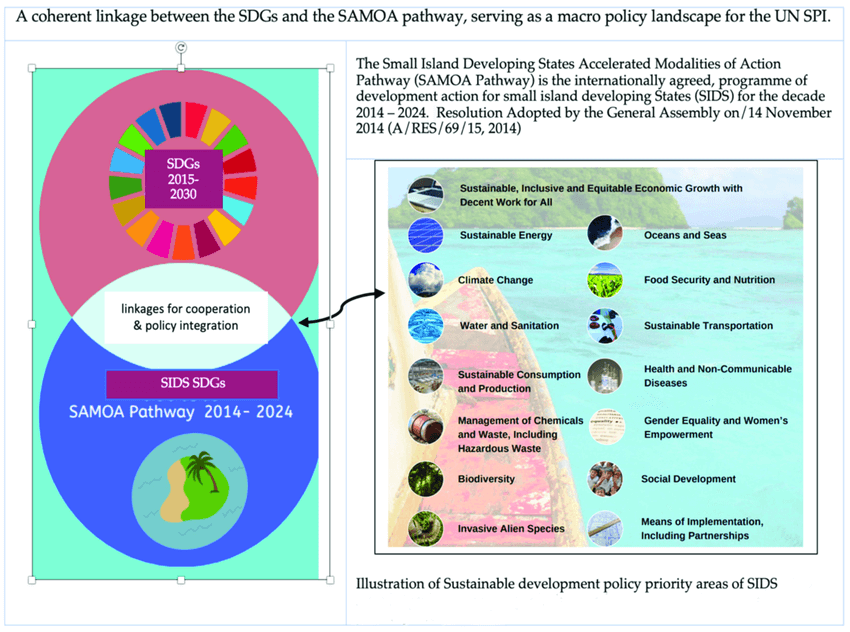
Answer: (a) Small Island Developing States (SIDS); Difficulty Level: Medium
Incorrect
Explanation
- The UN Secretary-General emphasizes the urgent need for increased funding to support Small Island Developing States (SIDS) facing climate change.
- Comprising 39 States and 18 Associate Members, SIDS, located in the Caribbean, Pacific, and Atlantic, Indian Ocean and South China Sea (AIS regions), exhibit unique vulnerabilities.
- Recognized as a special case in 1992, they suffer from low economic diversification, dependence on tourism, and high debt stress.
- The UN has established action programs like the Barbados Programme of Action and SAMOA Pathway to address SIDS’ challenges.

Answer: (a) Small Island Developing States (SIDS); Difficulty Level: Medium
Unattempted
Explanation
- The UN Secretary-General emphasizes the urgent need for increased funding to support Small Island Developing States (SIDS) facing climate change.
- Comprising 39 States and 18 Associate Members, SIDS, located in the Caribbean, Pacific, and Atlantic, Indian Ocean and South China Sea (AIS regions), exhibit unique vulnerabilities.
- Recognized as a special case in 1992, they suffer from low economic diversification, dependence on tourism, and high debt stress.
- The UN has established action programs like the Barbados Programme of Action and SAMOA Pathway to address SIDS’ challenges.

Answer: (a) Small Island Developing States (SIDS); Difficulty Level: Medium
-
Question 12 of 12
12. Question
Q12. {Prelims – PIN} Reykjanes Peninsula, recently seen in the news due to volcanic eruption, is located in which country?
Correct
Explanation
- In March 2024, Iceland declared a state of emergency after a volcanic eruption on the Reykjanes Peninsula.
- The eruption site is located a few kilometers northeast of Grindavik, a coastal town about 50 km southwest of Reykjavik, Iceland’s capital.
- The eruption has sent orange lava streams into the sky at night.
- The eruption has also led to the evacuation of nearby areas, including the Blue Lagoon, a well-known tourist attraction.
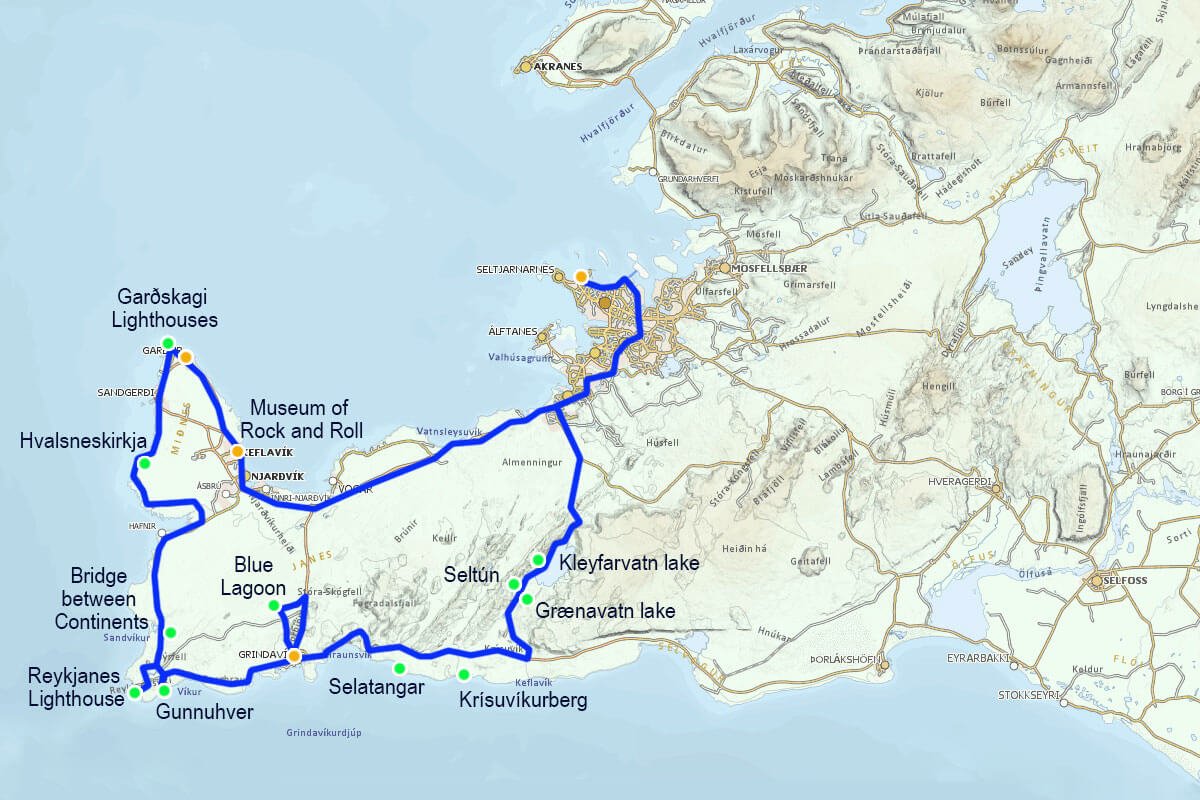
Answer: (c) Iceland: Difficulty Level: Medium
Incorrect
Explanation
- In March 2024, Iceland declared a state of emergency after a volcanic eruption on the Reykjanes Peninsula.
- The eruption site is located a few kilometers northeast of Grindavik, a coastal town about 50 km southwest of Reykjavik, Iceland’s capital.
- The eruption has sent orange lava streams into the sky at night.
- The eruption has also led to the evacuation of nearby areas, including the Blue Lagoon, a well-known tourist attraction.

Answer: (c) Iceland: Difficulty Level: Medium
Unattempted
Explanation
- In March 2024, Iceland declared a state of emergency after a volcanic eruption on the Reykjanes Peninsula.
- The eruption site is located a few kilometers northeast of Grindavik, a coastal town about 50 km southwest of Reykjavik, Iceland’s capital.
- The eruption has sent orange lava streams into the sky at night.
- The eruption has also led to the evacuation of nearby areas, including the Blue Lagoon, a well-known tourist attraction.

Answer: (c) Iceland: Difficulty Level: Medium
Newsletter Updates
Subscribe to our newsletter and never miss an important update!
Assured Discounts on our New Products!
Related Posts

January 30 2024 Prelims Practice Questions (PPQs)

February 28 2024 Prelims Practice Questions (PPQs)
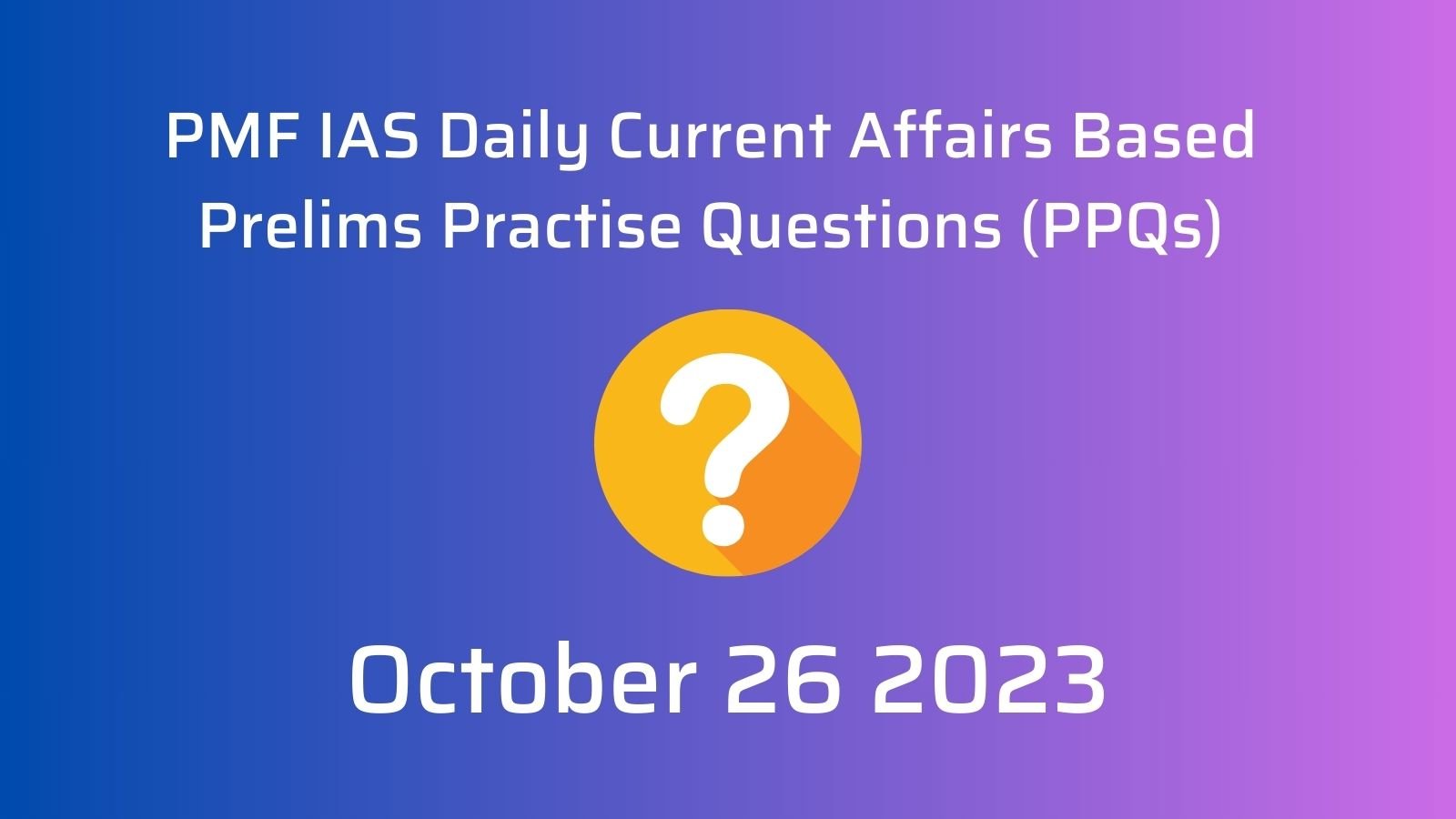
Daily Prelims Practise Questions (PPQs) – October 26 2023
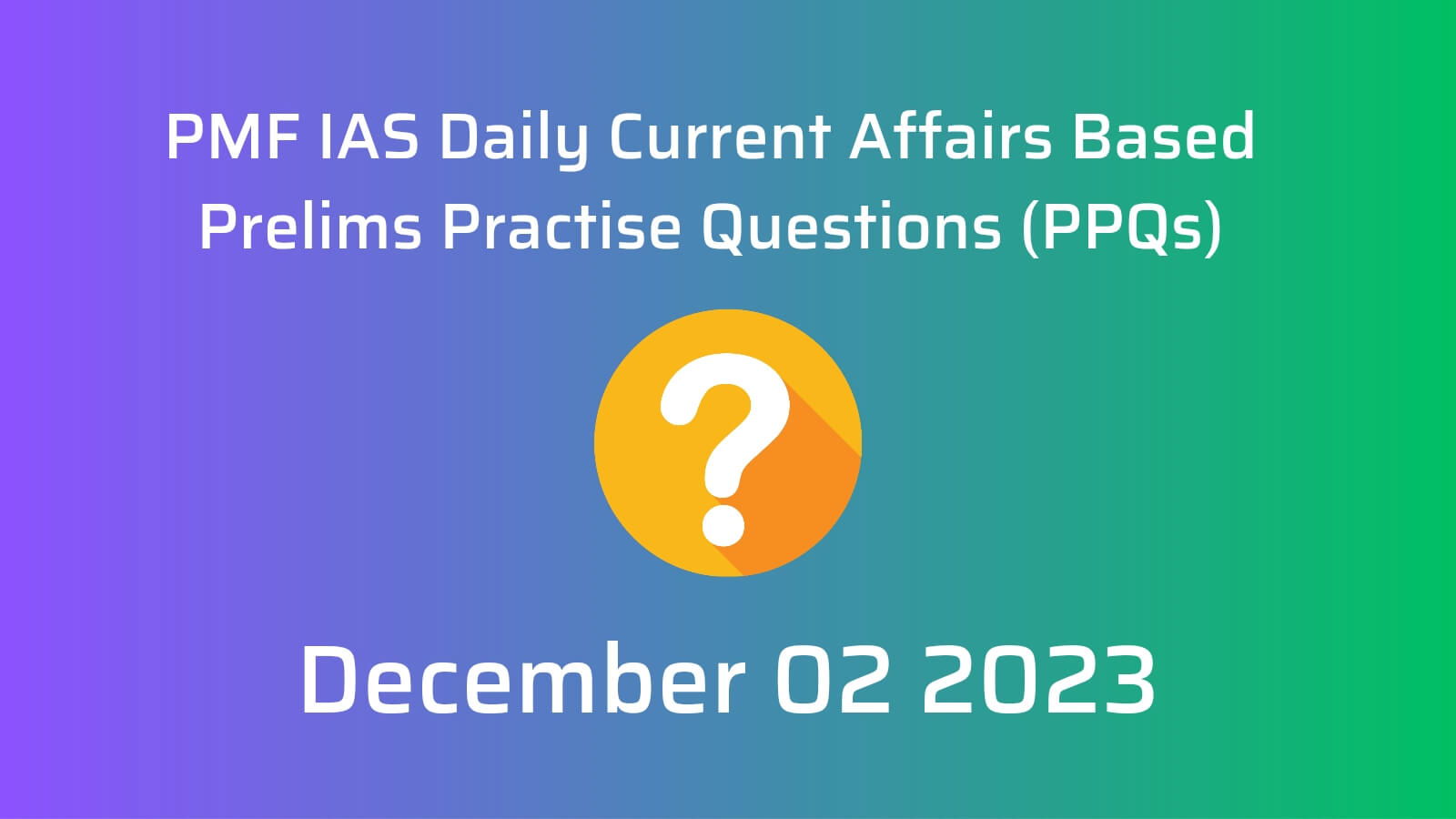
December 02 2023 Prelims Practice Questions (PPQs)

March 20-21 2024 Prelims Practice Questions (PPQs)
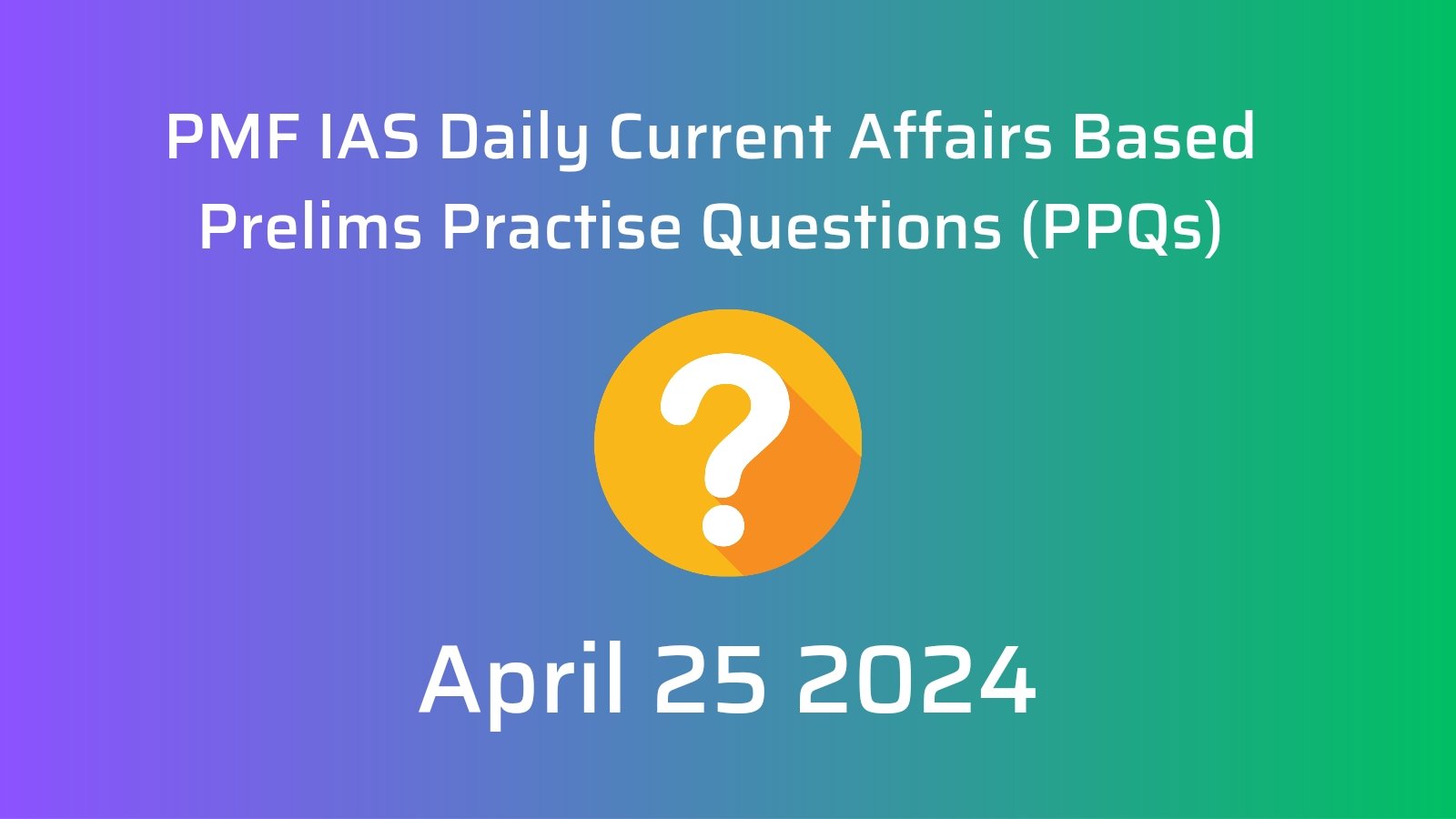
April 25 2024 Prelims Practice Questions (PPQs)

January 08 2024 Prelims Practice Questions (PPQs)





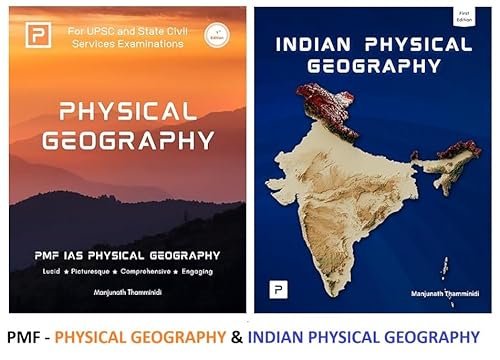
![PMF IAS Environment for UPSC 2022-23 [paperback] PMF IAS [Nov 30, 2021]…](https://pmfias.b-cdn.net/wp-content/uploads/2024/04/pmfiasenvironmentforupsc2022-23paperbackpmfiasnov302021.jpg)





